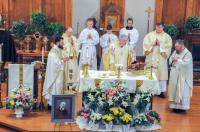Hundreds Visit St. Philip Parish, St. Padre Pio Relics

Bishop Joseph M. Siegel knew Father Claude “Dusty” Burns had a devotion to St. Padre Pio, so the bishop asked if he would host First Class Relics of the saint at St. Philip Parish in Posey County, where he is pastor.
Father Dusty didn’t hesitate — “absolutely,” he told the bishop.
The Posey County parish hosted First Class Relics of St. Pio of Pietrelcina, more commonly known as St. Padre Pio, on May 1. The relics were available for veneration throughout the day leading up to a Votive Mass, which concluded the day. About 300 people filled the pews at St. Philip Church as Bishop Siegel celebrated Mass.
Father Dusty and Father Chris Forler, pastor of St. John the Evangelist Parish in Daylight, concelebrated the Mass. Deacon Luke Hassler and Deacon Charlie Koressel assistant; and Matt Miller, Diocesan Director of Worship, served as Master of Ceremonies.
The six relics of St. Padre Pio on site for public veneration at St. Philip included: Saint Pio's glove; Saint Pio's crusts of the Stigmata wounds; cotton gauze with Saint Pio's blood stains; a lock of Saint Pio's hair; Saint Pio's mantle; and Saint Pio's handkerchief soaked with his sweat from hours before he died.
In Catholicism, First Class Relics are physical objects associated with a saint or candidate for sainthood, and can be part of the person’s body or something he or she was in contact with. They are not worshiped, but relics are treated with religious respect.
“It’s powerful because the relics of the saints are a touching point with heaven,” Father Dusty said. “We honor the saints because they are completely configured to Jesus, and so it’s recognizing someone who has officially been sealed with this person in heaven. So it increases our devotional life, but the ultimate end of these types of pilgrimages is to lead people to Jesus. They (saints) led people to Jesus during their lives and their deaths.”
Father Dusty wasn’t sure what kind of turnout to expect, but he said from the time public veneration started at 9 a.m. until the evening Mass began at 7 p.m., a “nonstop line of people” came to view and venerate the First Class Relics. An official count wasn’t taken, but he estimated many hundreds – possibly thousands – of people came from all over – including Kentucky, Tennessee, Ohio and Missouri.
Many students also visited the relics. When they placed a St. Padre Pio prayer card on some of the First Class Relics, the touch turned their prayer card into a Third Class Relic.
“There’s such a strong devotion to Padre Pio in the world and also in our country,” he said. “So I was pleasantly surprised, but not too surprised since it’s in his honor.”
St. Pio, who was born on May 25, 1887, in Pietrelcina, Italy, first expressed his desire to join the priesthood at age 10. At 23-years-old, he was ordained a priest.
During his lifetime, Padre Pio was known for his miraculous healing powers and knowledge. He is credited with several reliable incidents of bilocation, where he appeared completely and interacted with people in two places, often great distances apart, simultaneously.
Padre Pio also bore the stigmata. In Catholicism, stigmata is the term used to describe the wounds an individual receives that correspond to the crucifixion wounds of Jesus Christ. After Pope Benedict XV asked Christians to pray for an end to World War I, Padre Pio’s stigmata appeared. He had a vision in which Christ pierced his side, and a few weeks later, on Sept. 20, 1918, Jesus again appeared to him and he received the full stigmata. It remained with Padre Pio until his death on Sept. 23, 1968.
“Padre Pio is fascinating because he lived in the 20th century and there were things that science couldn’t explain like his wounds, his stigmata that he had for 50 years of his life,” Father Dusty said. “He carried the wounds of Christ. As the modern era was budding forth, he was one of the most mystical saints ever. He certainly is a saint of the 21st century because we have videos of him doing things we just cannot explain with the empirical method.”
Pope John Paul II canonized Padre Pio in 2002.
St. Padre Pio’s relics are on a tour of U.S. archdioceses and dioceses through June 15, and again in September and November. The tour is sponsored by the Saint Pio Foundation.
The 2017 and 2018 relic tour attracted about 500,000 faithful and made headlines across in the country including in The New York Times and The Wall Street Journal, and on NBC.
“The fact (Padre Pio) was just such a good and humble priest who said ‘I want to suffer with you for the salvation of souls;’ people are hungry for that type of devotion,” Father Dusty said.
It was an honor, he added, to host St. Padre Pio’s relics.
“The day has gone by real fast, and I’ll never forget it,” he said. “I think this whole parish in general will never forget this day. It’s a monumental day in the history of the diocese and of this parish.”
For more information about the Saint Pio Foundation, visit http://www.saintpiofoundation.org.




